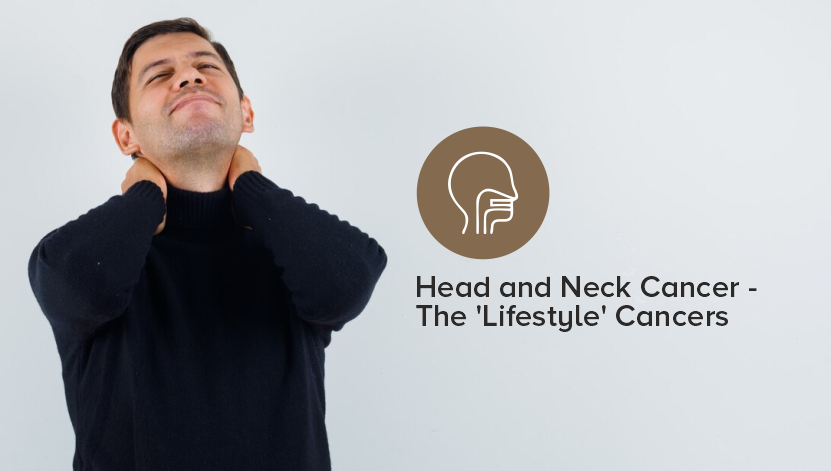Head and neck cancers are diseases that originate in the oral cavity, pharynx, larynx, paranasal sinuses, nasal cavity, or salivary glands. Although this group of cancers is less common than other types, they pose unique challenges due to their impact on essential everyday functions—eating, speaking, and vital parts of our social and emotional well-being.
These cancers often spur discussions around "lifestyle" and are frequently linked to factors such as smoking and alcohol consumption. But this oversimplification can lead to a lack of understanding regarding the complex nature of these diseases, the array of risk factors involved, and the challenges in diagnosis and treatment they present.

The term 'lifestyle' cancer often wrongly implies that an individual's choices are entirely responsible for the development of these diseases. This designation can inadvertently lead to a stigma surrounding patients who have been diagnosed, despite a mix of possible causes. For head and neck cancers, risk factors are indeed multifaceted, ranging from habits to heredity, environmental influences, and viral infections.
There is a strong association between the consumption of alcohol and tobacco and head and neck cancers. However, not all individuals with these habits will develop cancer, and not all head and neck cancer patients have a history of smoking or heavy alcohol use.
A well-balanced diet and good oral health can contribute to overall well-being and may play a protective role against head and neck cancers. However, poor oral hygiene and certain nutritional deficiencies can also be secondary causes, rather than being directly linked to tumor development.
Exposure to certain substances like asbestos, wood dust, and radiation, particularly through occupational settings, has been linked to an increased risk of head and neck cancers.
The human papillomavirus (HPV) is now recognized as a significant risk factor for oropharyngeal cancers. This understanding has shifted the demographics of these cancers, affecting younger, non-smoking individuals, and shaping prevention and treatment strategies.
Head and neck cancers often manifest in subtle but persistent signs that can be overlooked. Early diagnosis is key to successful treatment, underscoring the importance of awareness and regular health check-ups.
These cancers can start in the lips, the front two-thirds of the tongue, the gums, the lining inside the cheeks and lips, the floor (bottom) of the mouth under the tongue, the hard palate (bony top of the mouth), and the small area of the gum behind the wisdom teeth.
The pharynx is a hollow tube about 5 inches long that starts behind the nose and ends at the top of the trachea.
The larynx, also called the voice box, is a short passageway formed of cartilage located just below the pharynx.
The diagnosis of head and neck cancers often involves a combination of physical examinations, imaging tests, and biopsies. Early diagnosis can significantly improve the chance for successful treatment and preservation of function.
The treatment of head and neck cancers is complex due to the critical functions of the affected structures. The approach is multidisciplinary, involving surgeons, medical oncologists, radiation oncologists, and often, speech and swallow therapists, nutritionists, and mental health professionals.
Surgical options can range from minimally invasive procedures to complex operations that aim to remove as much of the tumor as possible while preserving function.
High-energy radiation is used to kill cancer cells. It can be given externally from a machine, or internally using a radioactive substance sealed in needles, seeds, wires, or catheters.
Medications used to kill cancer cells offered either alone or in combination with other treatments.
Certain drugs can block the growth of cancer cells by interfering with specific targeted molecules needed for carcinogenesis and tumor growth.
This treatment uses the body's immune system to help fight cancer, either by stimulating the immune system to work harder or by giving the immune system components it needs, such as man-made immune system proteins.
The impact of head and neck cancers goes beyond physical health. The psychological, emotional, and social aspects demand equal attention. Coping strategies, support networks, and rehabilitation programs are crucial parts of the recovery process.
The physical changes resulting from treatment may require the use of dental and facial prostheses, and in some cases, reconstructive surgery. This multidisciplinary approach helps patients regain their functionality and confidence.
Maintaining proper nutrition is often a challenge for individuals undergoing treatment for head and neck cancers. Working with a nutritionist and exploring alternate feeding options can significantly improve outcomes and quality of life.
Engaging with support groups can provide a sense of community and shared experience. Seeking the support of mental health professionals is equally important to navigating the emotional aspects of the disease.
Prevention is an essential aspect of managing the risk of head and neck cancers. Self-advocacy, through regular check-ups and prompt attention to any concerning symptoms, amplifies the likelihood of early intervention.
Quitting smoking and the use of smokeless tobacco can significantly reduce the risk of head and neck cancers.
Limiting the consumption of alcohol, particularly in combination with smoking, can be a protective measure.
Vaccination against HPV, ideally before the onset of sexual activity, is a preventive measure for HPV-associated oropharyngeal cancers.
Regular visits to healthcare providers, self-examinations, and growing awareness of the signs and symptoms can lead to early detection and better treatment outcomes.
Head and neck cancers are not just a health issue; they are a human issue. The complex web of factors that contribute to their development and the challenges they pose in fighting them demand a comprehensive, compassionate, and collaborative response. For comprehensive head and neck cancer treatment in India, American Oncology Institute is recognized as the top multi-disciplinary oncology hospital known for its expertise and advanced care.